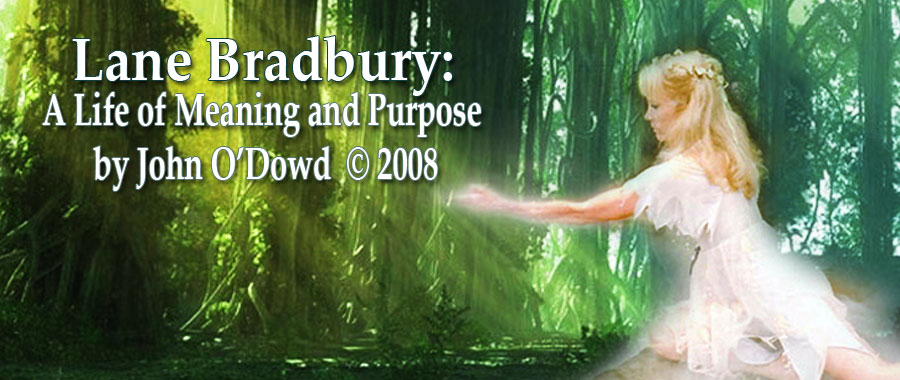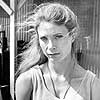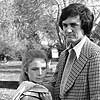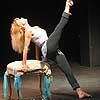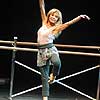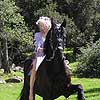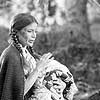Lane Bradbury: A Life of Meaning and Purpose – Page 5
| Last Update: 2008 | ||||
Page 5 of 6In the early 70s, when I was doing all these westerns, I was also doing a lot of other TV work, too. Let’s see, there was Medical Center… The Mod Squad… The Partridge Family.. .Mannix… The FBI… McCloud… McMillan and Wife… Banacek. There were so many of them! A lot of them, I’m sorry to say, I don’t even remember doing. When you do that much TV, the jobs just kind of run together after a while. For instance, I don’t have any specific memories of The Mod Squad. I do seem to remember it was a pleasant, fun experience. I jumped from a plane in a parachute and that’s about all I can tell you about it! On Medical Center, I don’t even remember the character I played. I mean, that job was nearly 40 years ago. That’s a long time back, you know? (laughs) The Partridge Family I remember because in real life I had had an operation to get pregnant and I did the show maybe a week and a half or two weeks after the operation. So after undergoing this life-altering operation that I’d had, the show seemed very…frothy. But I enjoyed doing it and what I remember most is walking through the scene feeling the fact that I’d had this big operation and that it was so monumental in contrast to the character I was playing.
The same year I did Mannix I guest-starred on several other television shows, including McCloud with Dennis Weaver. I absolutely loved working with Dennis. Lou (Antonio) directed that episode and I got to dance on the show, which was great. Police Story was fun because I got to play a prostitute in it and it was a very meaty part…a terrific acting role. Lou also directed me in McMillan and Wife and there was a scene in it where I had to kiss Rock Hudson. I remember that he was extremely shy in that scene, but what a kind and lovely man he was. In fact, most of the TV stars I worked with were wonderful and were absolutely always there for you. On the other hand, working with George Peppard on Banacek was a little bit…weird. Lou was friends with George and I remember feeling very uncomfortable during the shoot because he sort of put the make on me! Not hugely, but you know, he knew that Lou and I were a couple and so I thought it was very inappropriate of him to do that, to say the least. I would say that George Peppard had a pretty healthy ego! Other than that, Banacek was a fun show to do because I got to ride a race horse which may look easy, but it’s not. Let me tell you, my thighs really got a work out on that show! (laughs) In 1971, I played Sally Field’s younger sister in a TV movie called Maybe I’ll Come Home in the Spring, which was actually quite controversial at the time. It was one of her first adult roles after her work on Gidget and The Flying Nun and it really ushered in a whole new phase in her career. I loved working with Sally. We were always in cahoots…just like real sisters! However, I never got close to either Jackie Cooper or Eleanor Parker, who played our parents. They were sort of old-fashioned and I think they reminded me of my own parents so I chose to react to them as if they were. One time when I was a teenager my father had caught me kissing a boy in the recreation room and he called me upstairs and yelled at me and called me a whore. Well, I didn’t speak to him for six months afterward because I was so mad at him and I just gave him the cold shoulder. So I kind of drew on that memory when I was playing my scenes with Jackie and Eleanor. In another situation I probably would have wanted to get to know them better but the fact that I kind of distanced myself from them on the set helped me stay in character. My role in the film was that of an angry and rebellious teenager named “Susie” who hid out in her room and popped a lot of pills. It wasn’t an especially difficult part for me to play because I had already smoked pot by then and even took LSD one time (which was an absolutely horrendous experience). So I was able to pull up my memories of those experiences to get into the character. I really loved that job and the director, Joseph Sargent, made it all so easy. That show was all about good work—good, connected work. I remember doing The FBI because I got to play another prostitute! (laughs) That was kind of a special part. In the middle of doing all this TV work I was also auditioning for a lot of film roles, too. Some I got…some I didn’t get. One role that I was offered and turned down (and foolishly, I might add) was the Bonnie Bedelia part in They Shoot Horses, Don’t They? I didn’t take it because I was very full of my own ego at the time, and I thought the part was too small. Which was a mistake. I must say, I wasn’t real successful in making the changeover from television to films. But you know, it’s all part of the business we’re in. Dealing with rejection is always hard and at first you do take it personally. But over time you just have to say to yourself, ‘It’s not me, as a person, that they are rejecting, I’m just not what they’re looking for to play this part.’ Believe me, you know when you’ve done a good reading (and when you haven’t) and eventually I had to learn how to put more effort into my auditions. One of the film projects that I did get during this time was a real classic: Alice Doesn’t Live Here Anymore (1974). I played the emotionally and physically battered wife of Harvey Keitel and I only had one scene in the picture, but it was a good one. I didn’t even have to read for the role. I remember Martin Scorsese wanted me to come in to rehearse for it but I told him I didn’t want to because I wanted my performance to be really fresh. Well, that was kind of cocky of me, wasn’t it? (laughs) I thought I had cut my own throat (with that attitude), but I met Harvey Keitel for dinner the night before we shot and he said everything was okay. So the next day we’re on the set and I did my one scene with (the film’s star) Ellen Burstyn. Right afterwards, I remember telling Scorsese, nervy thing that I was, that ‘ I’ve got about two of these [performances] in me so can we try to get it in the can on the first or second take.’ I’m not sure that was such a smart thing to say to him, but I just wanted to be my best, and I knew the way I worked the best. Ellen was wonderful. She was always right there for me. I just loved playing that character. When Harvey breaks into the motel room where I’ve come to talk to Ellen…well, we rehearsed it once and then when it came time to shoot the scene, Ellen and I were both trembling. Neither one of us were acting because he was that scary! I remember crawling out of there on my hands and knees after he beat me up and going across all the broken glass but there was so much reality that once again I didn’t feel like I had to act. I just had to react to two wonderful talents that were so incredible that they made my job easy. Right after Alice, I did another film that still resonates with me. It was a Sci-fi film called The Ultimate Warrior (1975) with Yul Brynner. The story was set in New York in the year 2012 after a nuclear holocaust has wiped out most of civilization. I remember I burst into tears when I first walked onto the sound stage as I was standing on what used to be a main street in NYC in the ruins of what our world would look like after the atomic bomb. I had a rape scene in the film and I recall the director telling me after one of the takes that I shouldn’t struggle so hard as the boys were having a hard time holding me down. My feeling was, ‘Well, get stronger boys then, because I’m not going to let them rape me’. But there weren’t any stronger boys around so I finally toned down my struggling so the rape could proceed.The feeling of devastation and survival that I had from the bombed-out sets and from that rape scene stayed with me throughout the entire shoot…it was extremely powerful. I only wish the film had been as powerful. I remember going to a screening of it and being very disappointed with the end result. Unfortunately I had no scenes in the movie with Yul Brynner…my scenes were toward the beginning of the film and laid the way for his character to appear. It would have been interesting to work with him. The Ultimate Warrior was a brutal film and the scary thing is if we keep going the way we are, this could really be our future! From 1975 to about 1991 or 92 I worked mostly in television, but I worked a lot. In 1980 I had a pretty good part as a vulnerable and suddenly unemployed divorcee with three small children in the TV movie Where the Ladies Go. It was an ensemble-type show but most of my scenes were with the film’s star, Karen Black. Working with Karen was fine…I don’t recall having any problems with her. The director of the show, Teddy Flicker, was great. Very giving and supportive. He really worked hard to create an environment where all the actors could do their best work. The most memorable part of the shoot, I think, was that Lou Antonio, from whom I had gotten divorced in real life, played my boyfriend in the film. Obviously there was a lot of emotional stuff going on between us and I remember Teddy saying to me, “Just keep the lid on, Lane…keep the lid on.” (laughs) I loved doing TV. I certainly preferred it to doing stage work because I’d had three really big hits on Broadway where you repeat the same thing every night and it’s hard. For instance, Night of the Iguana demanded that I be very emotional and that I reach way down within myself every night and it was just excruciatingly hard work. I would find myself doing things in my real life that I probably wouldn’t have done in order to bring all that negative stuff to the stage. So I would end up using real stuff in my performance which can be really dangerous. Lou Antonio and I were divorced in 1976. Though we didn’t make it as a married couple, we did have two beautiful daughters together. Our first daughter, Elkin, was born in 1971 and Angelique was born in 1973. They both danced as youngsters [and loved it] and they are both happily married. Elkin is married to a director, Bobby Garabedien, who did a short film about three years ago called Most that was nominated for an Academy Award, and it is a beautiful, beautiful film. Elkin still dances. She and Bobby have two children: Colby, their son, is sixteen, and Jenny Drew, their daughter, is twelve. Angelique is married to Mark Hannah who is a sound producer and composer and she is a professional photographer. They have a four-year old daughter named Merivelle. I am very proud of my family. They are conscious and loving people and they’re all helping to make the world a better place. Thinking about Lou…well, he is the most amazing human being I know. I wish our marriage had worked out and it is mostly my fault that it didn’t I married him out of…well, I loved him, but I loved him as a friend and I think I married him out of a need to survive. In those years, I was a mess, a suicidal mess, and he was always there for me. Besides being a fantastic human being, Lou is an incredible director and the times I worked with him have been really fulfilling times where I knew I was doing the very best work I could do. He’s an incredible dad to his children and grandfather to his grandchildren.
If I had to choose my favorite roles I would say that all the work I did at The Actor’s Studio, as well as different scenes and different pieces that I’ve written, are among my very favorites. Also, Maybe I’ll Come Home In the Spring and Dial Hotline, where I played little rebel girls, troubled…I loved those characters. I also loved the Gunsmoke episodes. They were so much fun, as was Police Story. And the first TV show I ever did, The Outcasts of Poker Flat. These days I don’t think of making a comeback, I think of doing things my own way. That’s where I’m putting my focus now and it’s a different way of ‘coming back’, I think. It is so much more difficult today out here in L.A. to find work and to have an acting career. It’s like our economy….the money goes to a few very, very rich people and it keeps being filtered into their pockets and it’s the same way now, it seems, with the actors out here. It’s so hard to get a foothold in the business. I can remember when I was first working I didn’t want to do a series because to me it was like doing Broadway. It was a lot of repetition. The same character, you know, whereas when I got to go in and do a guest star role I got to do a lead and a different person each time and I got to experience different lives. There’s just a lot fewer of those roles now. These days, the main stars get all the meat. They’re not just setting up scenes for someone like me to come in and have the meat, they’re getting the meat themselves. The business nowadays is very scary. I tell people who ask me about becoming an actress or an actor out here, that it’s got to be the only thing possible that they can do. And if they have a choice, then don’t do it because it’s too hard and there is too much of it that’s unfulfilling. And reality TV shows have not helped at all!
Our current Valkyrie workshops are being documented by Jack Cochran so that we can see the progress of these kids. Jack is an amazing cinematographer and an amazing human being. He documents these kids lives, showing how absolutely heroic they are…a lot of their lives are just so unbelievably shattered. We’ve also done a film on Hector Aristizabal, who is a therapist and one of our mentors. Hector is a torture survivor from South America and he is a brilliant actor. I saw him do a one man show about his experiences called Viento Nocturno and it was breathtaking. We have now put it on film that’s just come out. This film needs to be seen. Not only is Hector’s performance extraordinary, so is Jack Cochran’s cinematography, as well as the music and sounds of Enzo Fina.
Go to page 6 of 6 |
||||
Please leave a comment below. or visit my retired guestbook, to see previous comments.

